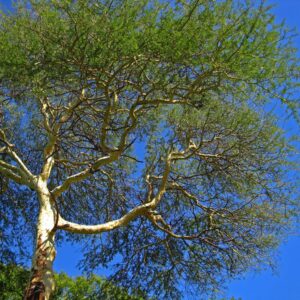Arbor Week: Let’s look at some of our enchanting trees

September 1-7 is National Arbor week, and in honour of this special month, compliments of Life is a Garden and with help from their industry experts – Random Harvest Nursery and Tree Factor, Estate Life shares some information on some of our enchanting indigenous trees, where to plant and how to maintain them.
Below are some of our more enchanting trees:
Sweet and special – The Snuffbox tree (Oncoba spinosa)
- Appropriately named after its local use for snuff making by crushing the edible hard-shelled fruit. The fruit is round and shiny red-brown in colour.
- They grow to a height of 3 to 4 metres, have a non-invasive root system, and will flourish in full sun with sandy, loam soil.
- Trees are valued for their dramatic white flowers that have a special melon-like scent, making them a perfect choice as a fragrant ornamental too.
Odd and extraordinary – The Sausage tree (Kigelia Africana)
- After treating us to a blood-red/maroon flower show that hangs off branches in long panicles, sausage-shaped fruit are an equally amazing sight.
- The smelly flowers, which bloom all night, attract pest-controlling bats that pollinate them. The sausage fruit is a huge berry and can grow up to 5m and weigh an astonishing 6.5kg’s! Beware – these sausage berries are not for human consumption but many garden visitors will feast on them.
- Grow these trees in full sun with composted soil that is slightly acidic to neutral.
“Ultimately, I believe if we don’t start planting trees in urban zones we’ll never catch up. If everyone plants at least one or two trees in their lifespan, it will make a huge difference” – Brett Hughes, Tree Factor.
Personality in a pot – The Forest elder (Nuxia floribunda)
- This angelic tree is full of fantasy with sweetly scented cream-white flowers borne in large clusters, resting whimsically upon the branch’s end.
- Ideal for the sun to semi-shade patio pot as the roots are non-invasive and branches can be pruned to maintain a lush, full and round shape.
- Flaky cream bark adds to the allure of this tree, as do the purplish branches that become paler with age – a real elder (or wise braai guardian).
More magical contenders
- Wild plum (Harpephyllum caffrum): best in warmer regions, is a delightful medium evergreen, produces berries for wildlife, and is ideal for screening off areas.
- Fever tree (Vachellia xanthophloea): a big and bold beauty with strong character, lovely foliage and flowers, and is a great nesting tree for birds (especially weavers).
- Paperbarks (Melaleuca quinquenervia): good for colder regions, have a lovely flat-topped habit and wide canopy, are wildlife attracting and perfect as a shade tree.
“A tree for the children to climb or to build a swing on. We plant trees for our future generation to enjoy” – Brett Hughes, Tree Factor.
Top tree maintenance tips
- Water well during the hotter summer months but seldom during winter.
- Never be afraid to prune your trees. Pruning encourages new growth and assists with light and air coming through to other leaves and branches.
- Protect trees that are planted on the lawn from lawnmowers and weed eaters. Many trees planted in lawns are killed or damaged due to ringbarking that will restrict a tree’s growth.
- To support young trees planted in lawn areas, create a dam around them to prevent your grass from taking all the nutrients and water.
- Remember to protect tender young trees from the cold during winter with frost cover for the first few years.
For the beginner botanical boss, try Jacket plum (Pappea capensis), Lavender tree (Heteropyxis natalensis), White ironwood (Vepris lanceolata), and Wild olive (Olea sub. Africana).


Sorry, the comment form is closed at this time.